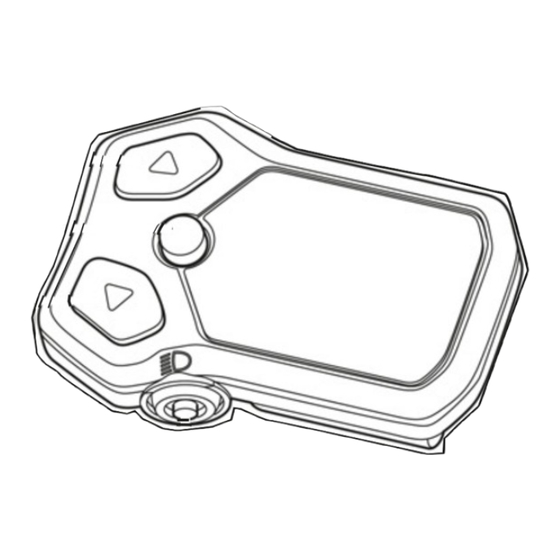
Table of Contents
Advertisement
Quick Links
Advertisement
Table of Contents

Summarization of Contents
About These Operating Instructions
1.4 For Your Information
Explains markings used for readability.
1.4.1 Warnings
Explains the three types of warnings used in the manual.
1.5 Type Number and Model
Lists pedelec models and their corresponding type numbers.
Safety
2.1 Residual Risks
Discusses potential hazards and risks associated with pedelec use.
2.1.1 Risk of Fire and Explosion
Details risks related to batteries, chargers, and hot components.
2.1.2 Electric Shock
Risks of electric shock from damaged components or water.
2.1.3 Risk of a Crash
Hazards leading to crashes and injuries.
2.2 Toxic Substances
Hazards from brake fluid, suspension oil, and battery liquids.
2.5 Personal Protective Equipment
Recommendations for helmets, shoes, and clothing for safety.
2.8 What to Do in an Emergency
Procedures to follow in emergency situations.
Description
3.1 Proper Use
Guidelines for correct and intended use of the pedelec.
3.1.1 Improper Use
Prohibited uses that pose risks of injury or damage.
3.3 Components
Identifies and describes the main parts of the pedelec.
3.3.2 Chassis
Details the frame and steering system components.
3.3.4 Wheel
Details the components of the wheel.
3.3.5 Braking System
Overview of the pedelec's braking system.
3.3.8 Electric Drive System
Overview of the electric drive system.
3.3.9 Rechargeable Battery
Battery protection, sleep mode, and capacity reduction.
3.3.12 On-Board Computer
Description of the SHIMANO SC-E5003 on-board computer.
Transporting and Storing
4.3 Transportation
Guidelines for transporting the pedelec and battery.
4.4 Storing
Recommendations for storing the pedelec and components.
4.4.1 Break in Operation
Procedures for preparing and carrying out a break in operation.
Assembly
5.2 Required Tools
Lists all tools needed for pedelec assembly.
5.3 Commissioning
Steps for initial setup and preparation for use.
5.3.1 Checking the Battery
How to check the battery's status before charging.
5.3.3 Installing the Wheel in the SUNTOUR Fork
Step-by-step guide for installing wheels in Suntour forks.
5.3.5 Fitting the Pedals
Instructions for correctly fitting the pedals.
5.3.6 Checking the Stem and Handlebars
Procedures for checking stem and handlebar connections.
Operation
6.1 Risks and Hazards
General overview of risks and hazards during operation.
6.2 Tips for a Greater Range
Strategies to maximize the pedelec's range.
6.3 System Messages
Explains warnings and error messages from the on-board computer.
6.5 Adjusting the Pedelec
Comprehensive guide to adjusting the pedelec for optimal fit and performance.
6.5.4 Adjusting the Saddle
Detailed steps for adjusting saddle height, position, and tilt.
6.5.5 Handlebars
Adjusting handlebars for rider comfort and control.
6.5.6 Stem
Adjusting the stem for handlebar height.
6.5.9 Brake
Adjusting brake levers for comfort and control.
6.5.12 Suspension
Adjusting fork and rear damper suspension.
Cleaning, Servicing and Maintenance
7.1 Before Each Ride
Pre-ride checks for safety and functionality.
7.3 Basic Cleaning
General cleaning procedures for the pedelec.
7.4 Servicing
General servicing procedures for pedelec components.
7.5 Maintenance
General maintenance procedures for the pedelec.
7.5.1 Wheel
Checking wheel security and concentricity.
7.5.2 Checking the Brake System
Inspecting the entire brake system.
7.5.3 Checking the Lighting
Verifying front and rear light function and alignment.
7.5.4 Checking the Stem
Inspecting stem security and corrosion.
7.5.5 Check the Handlebars
Checking handlebar security and twist.
7.5.6 Checking the Saddle
Verifying saddle stability and alignment.
7.5.9 Checking the Chain and Belt Tension
Checking and adjusting chain and belt tension.
Maintenance
8.1 Initial Inspection
Importance of initial inspection after purchase.
8.2 Maintenance
Requirement for regular, professional maintenance.
8.3 Component-Specific Maintenance Tasks
Need for specialized maintenance for high-quality components.
8.5 Maintenance Instructions
Table detailing maintenance intervals and procedures.
Troubleshooting, Fault Clearance and Repair
9.1 Troubleshooting and Fault Clearance
General approach to identifying and resolving issues.
9.1.1 The Drive System or Display Do Not Start Up
Steps to take if the drive system or display fails to start.
9.2 Assistance Function
Troubleshooting common issues with the assistance function.
9.3 Rechargeable Battery
Common battery issues and their solutions.
9.5.1 Suntour Suspension Fork
Troubleshooting specific issues with Suntour suspension forks.
9.5.1.1 Rebound Too Fast
Adjusting rebound damping for fast rebound.
9.5.1.2 Rebounding Too Slowly
Adjusting rebound damping for slow rebound.
9.5.1.3 Suspension Too Soft on Inclines
Adjusting compression for a softer fork.
9.6 Repair
General guidelines and procedures for repairs.
Recycling and Disposal
10.1 Removal of Waste Guidelines
Guidelines for disposing of different waste types.
Documents
11.1 Assembly Report
Information on the assembly report and its documentation.
11.2 Maintenance Instructions
Table for documenting maintenance status.
11.3 Parts List
Lists available parts for specific models.
Glossary
12.1 Abbreviations
List of abbreviations used in the manual.
12.2 Simplified Terms
Simplified terms for better legibility.
Appendix
I. Translation of the Original EC/EU Declaration of Conformity
Declaration of conformity details and applicable standards.













Need help?
Do you have a question about the QUADRANO LITE 11 and is the answer not in the manual?
Questions and answers